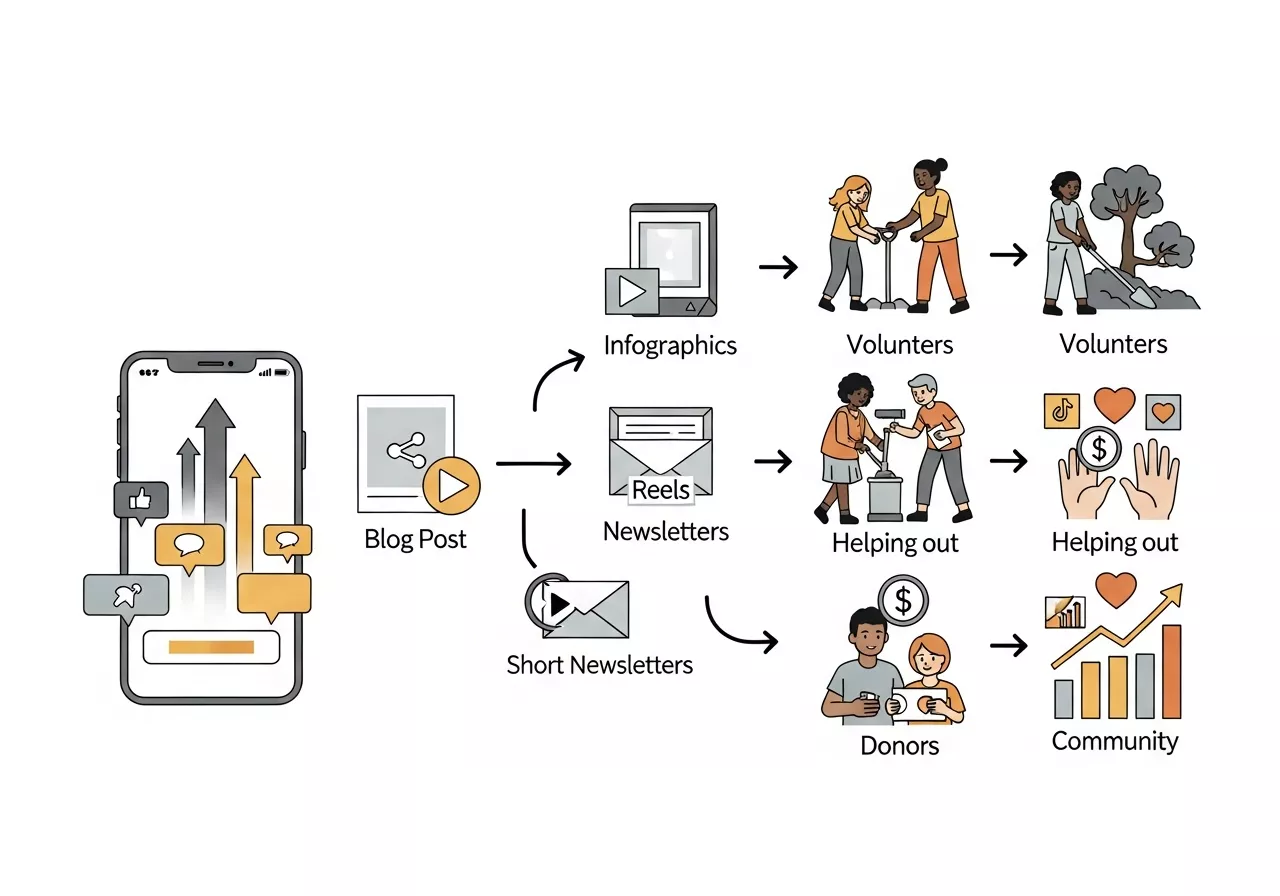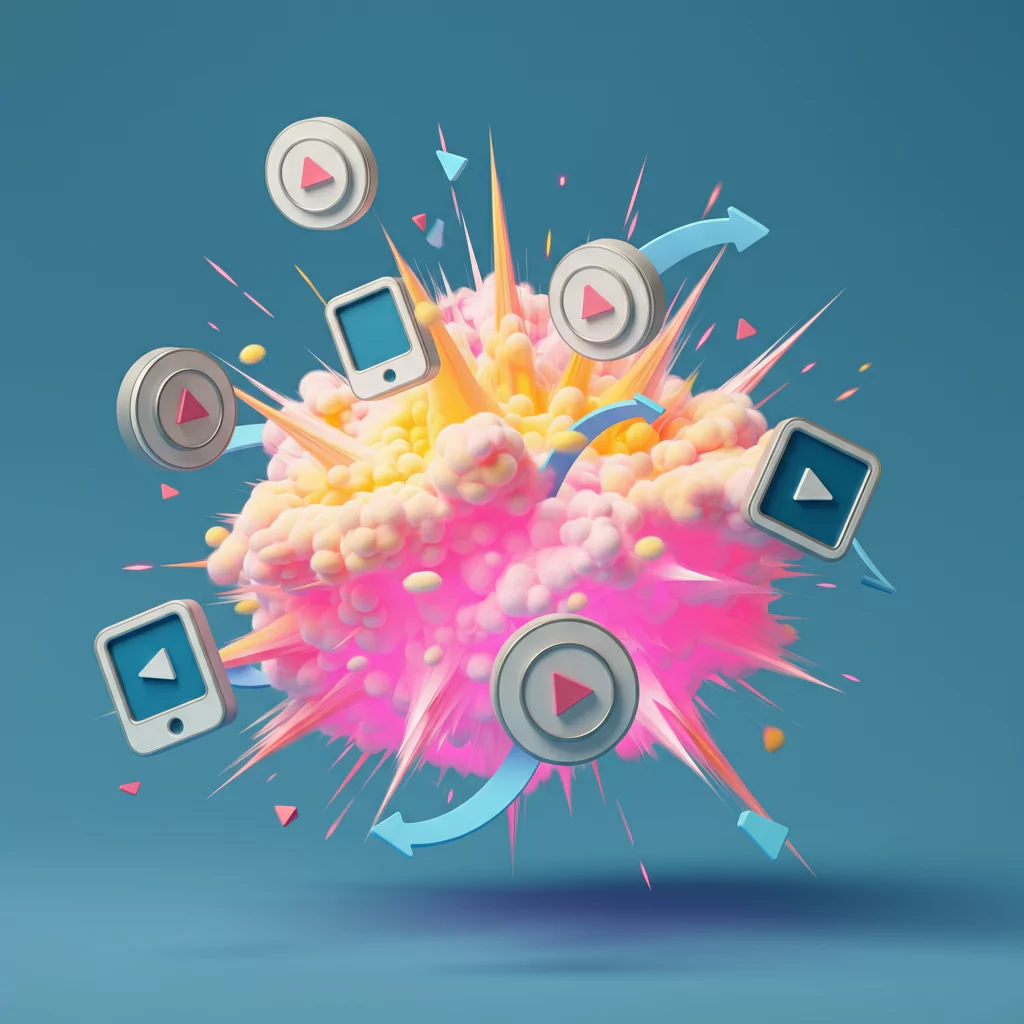
In a world dominated by social media noise, shrinking attention spans, and constant competition for visibility, nonprofits and NGOs face a unique challenge: how to break through the clutter with a message that truly matters.
While limited budgets and lean teams make large-scale ad campaigns difficult, there’s one powerful tool within reach—viral content. When a single post, video, or campaign catches fire, it can mobilize millions, raise unexpected funds, and generate invaluable awareness for your cause.
But virality isn’t just luck. It’s a blend of strategy, emotion, timing, and storytelling. In this blog, we’ll explore viral content strategies tailored for nonprofits and NGOs—approaches that help meaningful messages spread, spark change, and turn viewers into passionate advocates.
Why Virality Matters for Nonprofits
Going viral can mean more than just likes and shares for a mission-driven organization:
- Amplified Reach: Reach thousands or even millions without spending a fortune.
- Donor Awareness: Educate and engage potential donors in new ways.
- Volunteer Mobilization: Inspire people to take action quickly and passionately.
- Credibility: A well-received viral moment can establish your organization as a leader in your space.
But it’s not just about “going viral” for the sake of popularity. It’s about spreading your message as far and wide as possible to drive real-world impact.
Start with a Story Worth Sharing
The heart of any successful viral campaign is a story that evokes emotion—whether it’s joy, anger, hope, or compassion. Nonprofits are rich in stories of transformation, struggle, and triumph. The key is knowing how to tell them in a way that resonates online.
How to Do It:
- Focus on individual stories, not abstract statistics.
- Use real voices: Let beneficiaries, volunteers, or frontline workers speak.
- Highlight the before-and-after of someone helped by your work.
- Keep it human, honest, and relatable.
Example:
Charity: Water frequently goes viral by sharing the personal stories of people in communities who have gained access to clean water, paired with stunning visuals and emotionally-driven narratives.
Use the Power of Video

If there’s one content format made for virality, it’s video. Videos are easily shareable, auto-play on social media, and offer a dynamic way to convey emotion and information quickly.
Types of Videos That Go Viral:
- Short documentaries (2–5 minutes) telling personal stories.
- Day-in-the-life videos showing on-the-ground impact.
- Emotional thank-you videos for donors and volunteers.
- TikTok/Instagram Reels that educate or inspire in 15–60 seconds.
Tips:
- Hook viewers in the first 3 seconds.
- Use captions for sound-off viewing.
- Keep it visually compelling and emotionally driven.
Example:
The “Ice Bucket Challenge” wasn’t just a trend—it was a viral video campaign that helped the ALS Association raise over $100 million. Its success was in its simplicity, shareability, and emotional connection to a cause.
Tap Into Current Trends and Hashtags
Want to ride a viral wave? Look at what’s already trending and adapt it to your cause. Using current events, pop culture, or trending hashtags can give your content a wider runway.
How to Do It:
- Monitor trending hashtags on Twitter, Instagram, and TikTok.
- Use tools like Google Trends, BuzzSumo, or Exploding Topics.
- Apply the trend to your mission in a relevant, respectful way.
Caution:
Don’t force it. If a trend doesn’t align with your values or topic, skip it. Authenticity matters.
Example:
During Earth Day or Giving Tuesday, nonprofits often go viral by launching creative, timely campaigns tied to these widely recognized days.
Encourage User-Generated Content (UGC)
Your audience can be your biggest amplifier. Encouraging supporters to create and share content can not only spread your message but also make others feel personally invested.
Ways to Leverage UGC:
- Launch a hashtag challenge (e.g., #RunForCleanWater).
- Ask for stories from your volunteers or donors.
- Create a photo or video contest showcasing your impact.
- Repost supporter content across your channels.
Example:
Movember goes viral every year by asking men to grow mustaches in November and share their progress. It’s fun, visual, and tied directly to fundraising for men’s health.
Use Emotion-Driven Headlines and Captions
Your message might be powerful, but if your headline doesn’t grab attention, people won’t stop scrolling. Effective viral content strategies require click-worthy and emotionally engaging copy.

Tips for Writing Viral-Worthy Headlines:
- Ask a provocative question (e.g., “Could You Live on $1 a Day?”)
- Use numbers or statistics (e.g., “Every 90 Seconds, a Child Dies of a Waterborne Disease”)
- Evoke emotion (e.g., “This 7-Year-Old Walks 6 Miles Every Day for Water”)
- Highlight urgency (e.g., “Time Is Running Out for the Amazon Rainforest”)
Captions Should:
- Be clear, not clever.
- Include a strong call to action.
- Use emojis sparingly to boost visibility and emotion.
- Encourage comments and shares.
Make It Shareable (Literally)
Sometimes, content doesn’t go viral not because it isn’t good—but because it’s hard to share. Design your content to be easily replicated, reposted, and re-shared.
Shareability Checklist:
- Is your content mobile-friendly?
- Are there clear share buttons?
- Is your branding subtle, not overpowering?
- Can someone understand it in 5 seconds?
Also consider creating:
- Infographics with stats and facts.
- Quote graphics from key voices in your org.
- Downloadable toolkits for advocates or donors.
Example:
The UN’s “Global Goals” campaign went viral with a series of simple, bold images representing each goal—easy to share and align with.
Leverage Influencers and Micro-Advocates
Influencers aren’t just for brands. Nonprofits can tap into cause-driven creators, local micro-influencers, or passionate supporters with engaged followings.
How to Do It:
- Partner with advocates who genuinely care about your mission.
- Offer content or talking points—but let them speak authentically.
- Consider collaborations during key campaigns or awareness months.
Don’t forget:
- Influencers in the nonprofit space don’t always need to be paid.
- Partner with volunteers, activists, or thought leaders in your niche.
Example:
The #TeamTrees campaign was launched by YouTuber MrBeast and helped raise $20M to plant trees—proving that influencers can mobilize huge communities for good.
Leveraging Partnerships for Amplified Reach
No nonprofit operates in isolation. Collaborations and partnerships can multiply the reach of your viral campaigns, while also lending credibility and resources to your mission.
Types of Partnerships:
- Other NGOs/Nonprofits: Partner with organizations in complementary niches to cross-promote campaigns.
- Corporate Sponsors: Companies with aligned values can co-create content or provide amplification through their social channels.
- Media Outlets: Press coverage can make a campaign go viral beyond social media.
- Influencers and Advocates: Cause-driven creators, micro-influencers, and community leaders can exponentially increase visibility.
Steps to Maximize Partnerships:
- Identify partners with overlapping audiences.
- Co-create content that highlights both missions.
- Set clear expectations for promotion and shared metrics.
- Celebrate partner contributions publicly to encourage mutual advocacy.
| Partner Type | Example Collaboration | Potential Reach Boost | Benefits |
|---|---|---|---|
| NGO / Nonprofit | Co-launch a social media challenge | Access to complementary audiences | Shared credibility, pooled resources |
| Corporate Sponsor | Fund or promote campaign videos | Millions of followers via corporate channels | Increased amplification, brand trust |
| Media Outlets | Feature stories or interviews | Wide public exposure | Builds legitimacy, drives donations |
| Influencers | Challenge campaigns, shoutouts | Audience cross-pollination | Higher engagement and viral potential |
Pro Tip: Treat partnerships as long-term relationships, not one-off promotions. A strong network of advocates can help ensure multiple viral hits over time.
Make Your Audience the Hero
In your content, shift the spotlight from your organization to your supporters and beneficiaries. When people see themselves in your mission, they’re more likely to engage—and share.
How:
- Say “You helped plant 1,000 trees” instead of “We planted 1,000 trees.”
- Share photos of volunteers, donors, or partners in action.
- Celebrate your audience’s wins.
Viral Strategy:
Create a campaign where your audience completes a challenge, donates, or shares a story—and highlight their impact in real-time.
Use Platforms That Favor Viral Reach
Some platforms are more conducive to virality than others. For nonprofits, it’s essential to be on the right channels—not all of them.
Where to Focus:
- TikTok: Incredible organic reach for powerful short videos.
- Instagram Reels: Great for visual storytelling and challenges.
- Facebook: Still useful for community engagement and group mobilization.
- Twitter/X: Effective for real-time activism and trending conversations.
- YouTube Shorts: Rapidly growing platform for snappy content with high share potential.
Pro Tip: Don’t spread yourself too thin. Choose 2–3 channels where your audience already is, and tailor content for each.
Sustaining Viral Momentum Beyond the Initial Spike

Viral content has a short lifespan—often measured in hours or days. For nonprofits, the key is turning initial virality into sustained engagement and action.
Strategies to Sustain Momentum:
- Repurpose Content Across Platforms: Turn viral videos into infographics, blog posts, or Instagram carousels to keep the message alive.
- Follow-Up Campaigns: Launch mini-series or sequels to the original viral content. For example, share updates on the impact of a viral donation drive.
- Create Evergreen Assets: Save content that remains relevant over time—such as educational videos, case studies, or toolkits.
- Engage Your Audience: Respond to comments, feature user stories, and highlight donor or volunteer contributions to keep audiences invested.
- Track Performance & Iterate: Analyze which elements drove virality and replicate them in future campaigns.
| Strategy | Implementation Example | Benefit | Impact on Sustainability |
|---|---|---|---|
| Repurpose Content | Convert viral video into infographic | Extends lifespan, multiplatform reach | Keeps message in front of new audiences |
| Follow-Up Campaigns | Mini-video series on campaign progress | Maintains engagement | Encourages repeated donations or actions |
| Evergreen Assets | Educational blog posts, PDFs, toolkits | Long-term relevance | Generates consistent awareness and support |
| Audience Engagement | Feature volunteers or donor stories | Builds community and loyalty | Strengthens mission-driven advocacy |
| Data-Driven Iteration | Analyze viral metrics for future content | Refines strategy | Increases the probability of future virality |
Pro Tip: Momentum is more than going viral once—it’s about building a cycle of engagement, storytelling, and measurable action that continuously fuels your nonprofit’s mission.
Optimize for SEO and Discovery
Virality often starts on social, but longevity lives in search. Make sure your content is discoverable on search engines and platforms like YouTube.
SEO Tips for Nonprofits:
- Use keywords like your cause, location, or specific issue.
- Write blog posts or video descriptions with clear, relevant tags.
- Create “evergreen” content that remains relevant over time.
Example:
If your nonprofit fights ocean pollution, a blog post titled “10 Ways to Reduce Plastic Use in Your Daily Life” can continue attracting views—and shares—months after publishing.
Measuring the Impact of Viral Campaigns
Creating viral content is exciting, but for nonprofits, the real goal is impact, not just views or likes. To ensure your campaigns are effective, it’s essential to measure their performance and understand what works.
Why Measuring Matters:
- Determines ROI of content campaigns.
- Helps refine messaging for future virality.
- Highlight which stories resonate most with your audience.
- Provides data to attract donors, partners, and influencers.
Key Metrics for Nonprofits:
- Engagement Metrics: Likes, shares, comments, retweets, and reactions. High engagement often correlates with emotional connection.
- Reach & Impressions: How many people saw your content—critical for spreading awareness.
- Conversion Metrics: Donations, signups, volunteer applications, or petition signatures generated directly from viral content.
- Sentiment Analysis: Understanding whether audience reactions are positive, neutral, or negative.
| Metric Type | Example Measurement Tools | How It Helps Nonprofits | Key Insight |
|---|---|---|---|
| Engagement | Facebook Insights, Instagram Analytics | Determines content resonance | High engagement signals strong emotional connection |
| Reach & Impressions | Twitter/X Analytics, TikTok Analytics | Measures overall visibility | Indicates potential virality and awareness spread |
| Conversion | Google Analytics, Fundraising Platforms | Tracks tangible impact | Shows whether viral content translates into action |
| Sentiment Analysis | Brandwatch, Sprout Social | Understand audience perception | Helps refine messaging to stay positive and impactful |
Pro Tip: Track early engagement within the first 24–48 hours. Viral content momentum often depends on initial performance. Use these insights to iterate quickly for similar campaigns.
Final Thoughts: Make it Mission-Driven, Not Just Viral
Viral content strategies aren’t about chasing internet fame—they’re about amplifying your mission. For nonprofits and NGOs, the goal is to drive real-world action, whether that’s donations, volunteer signups, policy change, or simply raising awareness.
But virality without impact is just noise.
So tell great stories. Inspire real emotion. Encourage action. And remember—when your message is meaningful, the right strategy can help it spread far beyond what your budget allows.
Frequently Asked Questions (FAQ)
1. What is viral content for nonprofits and NGOs?
Viral content for nonprofits is content that spreads rapidly online while advancing a mission-driven goal—such as raising awareness, generating donations, mobilizing volunteers, or influencing social change.
2. Why is viral marketing important for nonprofits?
Viral marketing helps nonprofits reach large audiences without large budgets. It amplifies visibility, builds credibility, attracts donors and volunteers, and accelerates real-world impact through organic sharing.
3. Can nonprofits go viral without paid advertising?
Yes. Many nonprofit campaigns go viral through emotional storytelling, user-generated content, influencer advocacy, and timely trends. Authentic, relatable content often outperforms paid promotions.
4. What type of content works best for nonprofit virality?
Emotion-driven stories, short-form videos, user-generated challenges, trending hashtag campaigns, and impact-focused visuals perform best. Content that highlights real people and outcomes is especially effective.
5. How can nonprofits use trends without losing authenticity?
Nonprofits should only participate in trends that align with their mission and values. Adapting trends thoughtfully and respectfully ensures authenticity while increasing visibility.
6. Which platforms are best for viral nonprofit content?
TikTok and Instagram Reels offer strong organic reach, while Facebook supports community engagement. Twitter/X is effective for advocacy, and YouTube Shorts helps extend video-based storytelling.
7. How do nonprofits measure the success of viral content?
Success is measured through engagement (shares, comments), reach, conversions (donations, signups), sentiment, and real-world outcomes such as volunteer participation or policy impact.
8. How can viral content drive donations and action?
Viral content should include a clear call to action, emotional appeal, and easy pathways to donate, sign up, or participate. Highlighting urgency and impact significantly boosts conversions.
9. Are influencers necessary for nonprofit virality?
Influencers help but aren’t required. Micro-advocates, volunteers, and community members often create more trust-driven engagement. Passion for the cause matters more than follower count.
10. How can nonprofits sustain momentum after going viral?
By repurposing content, sharing impact updates, engaging new followers, launching follow-up campaigns, and turning viral moments into evergreen assets, nonprofits can extend reach and maintain engagement.
11. What mistakes should nonprofits avoid when creating viral content?
Avoid chasing trends without relevance, using misleading headlines, ignoring cultural sensitivity, or focusing on vanity metrics over real impact. Virality should always serve the mission.
12. Is viral content a long-term strategy for nonprofits?
Viral content should complement—not replace—a long-term strategy. Sustainable success comes from consistent storytelling, community building, and integrating viral insights into ongoing campaigns.
Learn more about: 9 Types of Viral Content That Actually Work










Leave a Reply